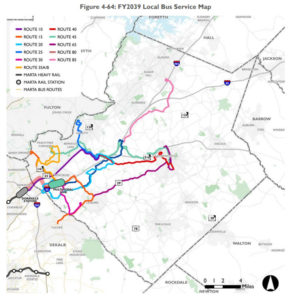By Elliott Brack
Editor and Publisher, GwinnettForum
MARCH 12, 2019 | If more transit options are approved in Gwinnett on March 19, what you will see soon in Gwinnett will be more buses, more routes and more frequency of bus service. All will be a major improvement in public transit in the county.
 We talked with Karen Winger, head of the Transit Division of the Gwinnett Department of Transportation, to understand these expanded local bus routes.
We talked with Karen Winger, head of the Transit Division of the Gwinnett Department of Transportation, to understand these expanded local bus routes.
Currently Gwinnett County Transit, which began local bus services in 2002, operates five bus routes and another five express bus routes, plus a pilot paratransit service in the Snellville area.
 Altogether, there will be some 160 miles of the proposed 10 local daily routes that will come with a “Yes” vote, some extending out of Gwinnett. The routes at the full build out will include:
Altogether, there will be some 160 miles of the proposed 10 local daily routes that will come with a “Yes” vote, some extending out of Gwinnett. The routes at the full build out will include:
- Gwinnett Place Transit Center to Doraville MARTA station (Route 10).
Peachtree Corners to Lilburn (15). - From Multi-Modal Center at Jimmy Carter via Singleton Road to Steve Reynolds Boulevard to Gwinnett Place Mall (20).
- From Multi-Modal Center via Breckenridge Boulevard to the Infinite Energy Center (25.)
- From Lilburn to the Multi Modal Center (30).
- From the Multi Modal Center to Peachtree Corners (35).
- Gwinnett Place Transit Center to Lawrenceville, via Gwinnett Tech and Gwinnett Medical Center (40).
- Peachtree Corners, via Gwinnett Mall and Infinite Energy Center to Georgia Gwinnett College and Lawrenceville (45).
- From Tucker via U.S. Highway 29 to Lawrenceville and Georgia Gwinnett College (65).
- From Mall of Georgia on the eastside to I-985 Park-Ride Lot at Buford (85).
Commuter bus service will be expanded, with several more pick-up points. These buses will run directly from their origin to downtown areas. At present, there is commuter service only from Indian Trail Road, Sugarloaf Mills and I-985 in Buford.
Additional commuter pick-up points will initially be in the Hamilton Mill area and in Loganville. Eventually other starting points will include the areas of McGinnis Ferry Road; Braselton; Oakwood in Hall County, at Harbins and two other areas not yet named along Georgia Highway 316; and at four points along U.S. Highway 78. (Some of these areas are presently served by the Georgia Regional Transit Authority (GRTA). All these routes will run every five or ten minutes during peak hours, with other frequencies depending on demands of the ridership.
Winger injects a new thought into what could happen. “We are planning to offer to riders the possibility of a subsidized door-to-door service. That is, firms like Uber and Lyft could pick up people at their home and be driven to connect with a bus stop or transit station. This would be a ‘last mile’ connection to the transit sites.”
Another element of the overall transit plans calls for additional sidewalk construction in residential areas that would extend to transit pick-up sites.
In order to recap, the transit vote would essentially provide five forms of transit service:
- Paratransit Flex Service, already in operation and expandable to other less dense areas relatively soon.
- More local bus service in operation perhaps by 18-24 months, as soon as new buses can be built.
- Rapid Bus Service along specific routes, relatively soon.
- Bus Rapid Transit: within five-ten years.
- A new Multi-Model station in Norcross, at least 10 years out.
What could come: passage of the transit vote March 19 could begin a vast change in movement of people, connecting Gwinnett to areas across the entire Metro Atlanta area, and laying the basis for greatly improved service in the future.
- Have a comment? Send to: elliott@brack.net










Follow Us